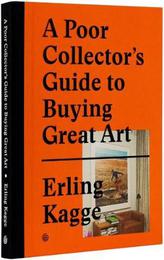
|
A Poor Collector's Guide to Buying Great Art
Hardback
Main Details
| Title |
A Poor Collector's Guide to Buying Great Art
|
| Authors and Contributors |
Created by Erling Kagge
|
| Physical Properties |
| Format:Hardback | | Pages:187 | | Dimensions(mm): Height 246,Width 173 |
|
| Category/Genre | Art: the financial aspect
Pictures, prints and maps |
|---|
| ISBN/Barcode |
9783899555790
|
| Audience | |
|---|
|
Publishing Details |
| Publisher |
Die Gestalten Verlag
|
| Imprint |
gestalten
|
| Publication Date |
29 May 2015 |
| Publication Country |
Germany
|
Description
Today's art market is incredibly dynamic. There are so many compelling works, shows, and exhibitions to choose from and new galleries are opening all the time. Because there is so much to discover and see, many people are getting interested in collecting art. But since it's impossible to keep track of all developments, becoming an art collector is not easy. A Poor Collector's Guide to Buying Great Art provides relief and offers sound advice to those who want to buy art but don't know how or where to do it. They might have preferences in terms of styles or techniques, but they're not familiar with how the buying process works. Perhaps they already have specific pieces in mind but don't yet trust the rules of the art market --if such rules actually exist. What does someone actually need to know to prevent their personal tastes from leading them to make the wrong investment decisions? On his way to becoming a passionate art collector himself, Norwegian adventurer Erling Kagge had to learn these ropes and answer this exact question. His years as a mountain climber and visitor to both poles undoubtedly helped him to explore and assess the extremes of the art market. Thankfully for us, his experience also gave him the desire and skills to impart his knowledge to others in A Poor Collector's Guide to Buying Great Art. This book illuminates all aspects of becoming an expert at buying art that one will enjoy for many years, such as how to get started, how to take one's tastes seriously, how to do a targeted search for pieces, how to learn to appraise prices, and how to find trustworthy partners. Kagge's practical yet entertaining step-by-step guidance also includes ways to identify and avoid pitfalls and deceptive temptations. As an extreme athlete, he knows very well how to follow rules yet trust his instinct where it counts. This know-how has benefitted Kagge on the art market and now it will benefit all readers of A Poor Collector's Guide to Buying Great Art, too.
Reviewsadvises collectors to push their limits when buying artworks. -- NORWEGIAN ARTS JOURNAL & SOTHEBY'S
|